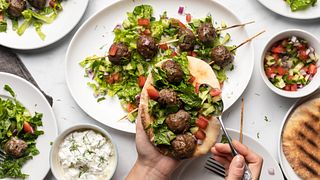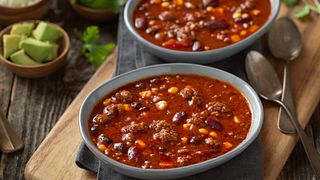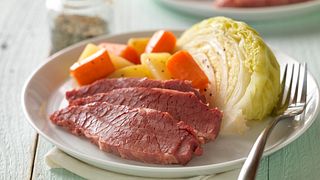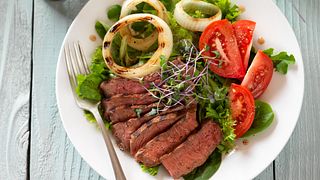All about lean beef
The Dietary Guidelines for Americans encourages consumers to choose “a variety of protein foods” which includes lean meats and poultry.1 Lean beef is a great option as it delivers more than 10 essential nutrients such as protein, vitamin B12, selenium, zinc, niacin, vitamin B6, phosphorus, choline, iron and riboflavin.2
What does Lean Mean?
“Lean” isn’t a marketing term: there is a government definition of what makes a cut of beef lean. To be considered lean, a 3-oz serving of cooked beef must have less than 10 grams of total fat, 4.5 grams or less of saturated fat, and less than 95 mg of cholesterol.3
Today's Beef is Leaner than Ever
Thanks to enhancements in cattle breeding and feeding, as well as improved trimming practices, more than 60 percent of whole muscle cuts found in the supermarket are considered lean when cooked with visible fat trimmed. In fact, the number of beef cuts that qualify as “lean” has increased sixfold from 1989 to 2013 .4 This is because of a multi-decade, coordinated effort by cattle farmers, ranchers and processors to meet the growing consumer demand for lean beef. It starts with careful breeding and includes ongoing monitoring and improving the feed type and amounts. Providing cattle exercise by allowing them to graze in pastures helps enhance muscle and encourage leanness, as well.
Is Grass-fed Beef Leaner Beef?
Contrary to popular belief, all cattle spend a majority of their lives eating grass on pastures. Some cattle may be “grass-finished,” meaning the cattle spend their entire lives on a pasture, whereas other cattle are grain-finished, moving from the pasture to a feedlot. And while grass-finished cattle tend to be leaner,5 there are a number of variables that contribute to leanness, including breed, age, grade and cut.6
Lean: All the Taste with Less of the Fat
Resources for Health Professionals
- Lean Matters: The story of lean beef and monitoring for/updating Standard Reference data
- Beef & Health
- Today's Beef Choices
- Research Paper: Impact of grass/forage feeding versus grain finishing on beef nutrients and sensory quality: The U.S. experience, Meat Science 2014
- Surprising Facts about Lean Beef
- U.S. Department of Health and Human Services and U.S. Department of Agriculture. 2015–2020 Dietary Guidelines for Americans. 8th Edition. December 2015. Available at http://health.gov/dietaryguidelines/2015/guidelines/
- U.S. Department of Agriculture, Agricultural Research Service, Nutrient Data Laboratory. USDA National Nutrient Database for Standard Reference, Release 28 (Slightly revised). Version Current: May 2016. Available at http://www.ars.usda.gov/ba/bhnrc/ndl
- U.S. Department of Agriculture, Food Safety and Inspection Service. Beef from Farm to Table. Available at
- National Cattlemen’s Beef Association, a Contractor to the Beef Checkoff Program. Lean Matters: Chronicling Beef’s Change from Gate to Plate. 2014. Available at https://embed.widencdn.net/download/beef/iyg5bxcz6u/LeanMatters_Web.pdf?u=q5atpk
- Daley CA, et al. A review of fatty acid profiles and antioxidant content in grass-fed and grain-fed beef. Nutr J 2010;9:10.
- Van Elswyk ME, McNeill SH. Impact of grass/forage feeding versus grain finishing on beef nutrients and sensory quality: the U.S. experience. Meat Sci 2014;96:535-40.








